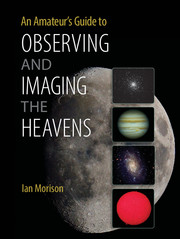Book contents
- Frontmatter
- Dedication
- Contents
- Preface
- Acknowledgements
- Prologue A Tale of Two Scopes
- 1 Telescope and Observing Fundamentals
- 2 Refractors
- 3 Binoculars and Spotting Scopes
- 4 The Newtonian Telescope and Its Derivatives
- 5 The Cassegrain Telescope and Its Derivatives
- 6 Telescope Maintenance, Collimation and Star Testing
- 7 Telescope Accessories
- 8 Telescope Mounts
- 9 The Art of Visual Observing
- 10 Visual Observations of the Moon and Planets
- 11 Imaging the Moon and Planets
- 12 Observing and Imaging the Sun
- 13 Observing and Imaging with an Astro-Video Camera
- 14 DSLR Deep-Sky Imaging
- 15 Imaging with Cooled CCD Cameras
- 16 Auto-Guiding and Drift Scan Alignment
- 17 Spectral Studies
- 18 Improving and Enhancing Images in Photoshop
- Index
- Plate Section
14 - DSLR Deep-Sky Imaging
Published online by Cambridge University Press: 05 June 2014
- Frontmatter
- Dedication
- Contents
- Preface
- Acknowledgements
- Prologue A Tale of Two Scopes
- 1 Telescope and Observing Fundamentals
- 2 Refractors
- 3 Binoculars and Spotting Scopes
- 4 The Newtonian Telescope and Its Derivatives
- 5 The Cassegrain Telescope and Its Derivatives
- 6 Telescope Maintenance, Collimation and Star Testing
- 7 Telescope Accessories
- 8 Telescope Mounts
- 9 The Art of Visual Observing
- 10 Visual Observations of the Moon and Planets
- 11 Imaging the Moon and Planets
- 12 Observing and Imaging the Sun
- 13 Observing and Imaging with an Astro-Video Camera
- 14 DSLR Deep-Sky Imaging
- 15 Imaging with Cooled CCD Cameras
- 16 Auto-Guiding and Drift Scan Alignment
- 17 Spectral Studies
- 18 Improving and Enhancing Images in Photoshop
- Index
- Plate Section
Summary
As the cost of large-sensor cooled CCD imaging systems has, until recently, been very high, many astro-imagers wanting to make wide-field images of the sky have taken to using DSLR cameras. With their inbuilt colour filters forming a Bayer matrix above the sensor, colour images are easily produced without the cost of the filters and filter wheels that are used with the majority of CCD cameras − not to mention the increased image processing time that is then required afterwards.
There is no doubt that Canon DSLRs have, up to now, been the choice of virtually all astro-imagers, with Canon providing free software to allow computers to remotely control their cameras and download the resulting images. Two more sophisticated programs to control Canon cameras are ‘Astro Photographic Tool’ (APT), which is freeware, though a small payment is (rightly) requested, and ‘Backyard EOS’, which is somewhat more expensive. Both allow sequences of exposures to be made so that the imaging system can be left unattended. They also record the sensor temperature for each exposure, which can be very useful if ‘dark frames’ are to be subtracted in the image processing software rather than in the camera, as will be discussed later. For example, APT can add the sensor temperature to the file name as in ‘L_3745_29C’, where L indicates a light frame.
- Type
- Chapter
- Information
- An Amateur's Guide to Observing and Imaging the Heavens , pp. 223 - 242Publisher: Cambridge University PressPrint publication year: 2014



